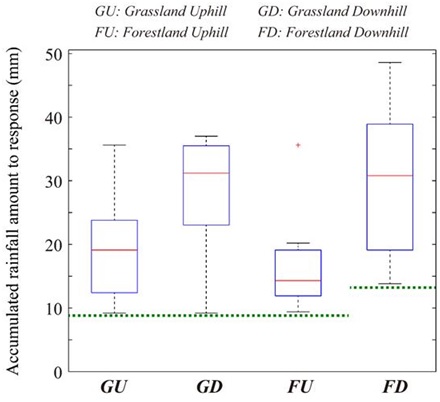Water balance and soil erosion are two core issues in the ecosystem management of the Loess Plateau of China (CLP). A number of studies demonstrated that soil erosion rate on the CLP and sediment load in the Yellow River significantly decreased due to the implementation of Grain for Green Project on the CLP during the past ~20 years.
Many studies clearly show that vegetation rehabilitation has played a significant role in controlling soil erosion on the CLP. However, the amount of water resources on the CLP also significantly decreased due to the increased cover of vegetation and many well-revegetated catchments do not generate stream flow for many years. Currently, it is extremely important to understand the mechanisms and thresholds of soil water recharge and runoff generation after the long-term human and natural vegetation rehabilitation on the CLP.
Based on the issues of soil water recharge and runoff generation under the background of large scale Grain for Green Project and significantly increased cover of vegetation on the CLP, Dr. JIN Zhao collaborated with the domestic and overseas scientists and chose a pair of catchments on the CLP (forested and natural regrowth) to explore the mechanisms and thresholds of soil water recharge under the human and natural well-revegetated ecosystems (Fig. 1).
The research showed that at least an accumulated rainfall amount of 9 mm was required to effectively recharge the surface soil moisture (10 cm) in the natural regrowth of grassland sites (uphill slope and downhill gully), whereas at least 14 mm of rainfall was required for the forestland gully site covered by dense undergrowth and trees (Fig.2). The results indicated that vegetation rehabilitation played a critical role in regulating rainwater infiltration and runoff generation. Overall, findings of this study revealed the transient dynamics of soil moisture after rainfall on the CLP and concluded that vegetation, topography, and rainfall attributes together determined rainwater infiltration and soil moisture replenishment.
The researches also discussed that, afforestation and natural regrowth of grasslands as the two mostimportant measures for vegetation restoration on the CLP, there is a trade-off between the impacts of afforestation and natural recovery of grassland on soil and water conservation. Natural regrowth of grassland is beneficial to water resources balance, thus many studies recommend that natural regrowth can offer a more adaptive method of ecological restoration onthe CLP. In this study, we also found that soil moisture was depleted the most at the forestland gully site after the 60-year vegetation rehabilitation. However, many studies indicated that afforestationis more efficient in flood control and soil erosion reduction than the natural regrowth of grassland on the CLP. Therefore, a more comprehensive evaluation of the ecosystem services, especially the critical zone services of the two vegetation measures on the CLP should be considered in the future.
This work was published in Hydrological Processes.

Fig.1 The study site is located in the Chinese Loess Plateau (CLP) in northern China. The paired catchments are selected in the Nanxiaohegou watershed after a long-term vegetation rehabilitation, including a grassland catchment (c) and a forestland catchment (d).

Fig.2 The accumulated rainfall amount before the soil moisture at 10 cm depth responding to all of eight responded rainfall-soil moisture response processes across the four monitoring sites. The green dashed lines indicate the threshold rainfall amount to trigger soil moisture response at 10 cm depth.
Contact: Bai Jie, Institute of Earth Environment, Chinese Academy of Sciences, Xi'an, China. Email:baijie@ieecas.cn
 © 2015 Institute of Earth Environment,CAS
© 2015 Institute of Earth Environment,CAS Address:No. 97 Yanxiang Road, Xi'an 710061, Shaanxi, China

 Location :
Location :